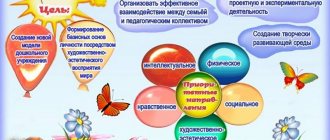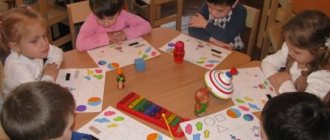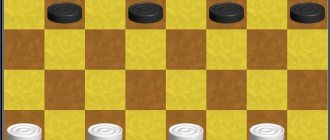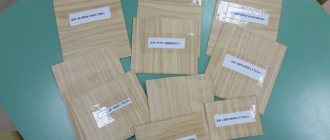The use of visual material in teaching children elementary mathematical concepts
CONTENT
1. The importance of visualization in teaching children the elements of mathematics. 3
2. Types of visual material used in the development of elementary mathematical concepts in preschoolers. 5
3. Pedagogical requirements for visual material and its use at different stages of teaching preschoolers elementary mathematical concepts 7
4. Selection of visual aids for work on the development of elementary mathematical concepts in children of a particular age group.. 9
References.. 11
1. The importance of visualization in teaching children the elements of mathematics
In the theory of learning, a special place is given to learning tools and their influence on the result of this process.
The means of teaching are understood as: sets of objects, phenomena (V.E. Gmurman, F.F. Korolev), signs (models), actions (P.R. Atutov, I.S. Yakimanskaya), as well as the word (G.S. Kasyuk, A.R. Luria, M.N. Skatkin, etc.), participating directly in the educational process and ensuring the assimilation of new knowledge and the development of mental abilities.
We can say that teaching aids are sources of obtaining information; as a rule, they are a set of models of a very different nature.
There are material-object (illustrative) models and ideal (mental) models.
In turn, material-subject models are divided into physical, subject-mathematical (direct and indirect analogies) and spatio-temporal.
Among the ideal ones, a distinction is made between figurative and logical-mathematical models (descriptions, interpretations, analogies).
Scientists M.A. Danilov, I.Ya. Lerner, M.N. Skatkin understands “means” as “with the help of which the transmission of information is ensured - the word, visualization, practical action.”
Teaching mathematics in kindergarten is based on specific images and ideas.
These specific ideas prepare the foundation for the formation of mathematical concepts on their basis. Without enriching sensory cognitive experience, it is impossible to fully acquire mathematical knowledge and skills.
Making learning visual means not only creating visual images, but also involving the child directly in practical activities. In mathematics classes and in kindergarten, the teacher, depending on the didactic tasks, uses a variety of visual aids. For example, to teach counting, you can offer children real (balls, dolls, chestnuts) or fictitious (sticks, circles, cubes) objects. Moreover, objects can be different in color, shape, size.
Based on a comparison of different specific sets, the child draws a conclusion about their number, in this case the visual analyzer plays the main role.
Another time, these same counting operations can be performed by activating the auditory analyzer: offering to count the number of claps, hits on a tambourine, etc. You can count based on tactile and motor sensations.
The principle of visual teaching is based on the real ideas of students.
This is one of the most well-known and intuitive principles of learning, used since ancient times. A logical justification for this principle was obtained relatively recently: human sensory organs have different sensitivity to external stimuli; in the vast majority of people, the organs of vision have the greatest sensitivity.
Thus, having examined the historical development of the principle of visibility, we can come to the conclusion that such teachers as Komensky Ya.A., Ushinsky K.D., Pestalozzi I.G. made a great contribution to the theoretical development and application of the principle of visibility. and etc.
Comenius believed that the principle of visual teaching presupposes, first of all, that students acquire knowledge through direct observations of objects and phenomena, through their sensory perception. Comenius considers visibility to be the golden rule of learning.
Ushinsky contributed a lot of valuable things to the theoretical development and application of the principle of visibility: he gave a materialist justification for the principle of visibility.
He gave visibility its place in the learning process; he saw in it one of the conditions that ensures that students receive complete knowledge and develop their logical thinking.
Pestalozzi reveals the essence of the principle of visibility more widely than his predecessors. He fills it with new content, considering visibility as the foundation for the comprehensive development of the child. It should be noted that modern principles of didactics determine the requirements for all components of the educational process - the logic of learning, goals and objectives, the formation of content, the choice of forms and methods, stimulation and analysis of achieved results. Having studied the material, we can conclude that visibility in didactics is one of the most well-known and intuitively understood teaching principles, used since ancient times. A logical justification for this principle was obtained relatively recently: human sensory organs have different sensitivity to external stimuli; in the vast majority of people, the organs of vision have the greatest sensitivity.
2. Types of visual material used in work on the development of elementary mathematical concepts in preschoolers
Visual aids can be real objects and phenomena of the surrounding reality, toys, geometric shapes, cards depicting mathematical symbols - numbers, signs, actions.
When working with children, various geometric shapes are used, as well as cards with numbers and signs.
Verbal clarity is widely used - a figurative description of an object, a phenomenon of the surrounding world, works of art, oral folk art, etc.
The nature of visualization, its quantity and place in the educational process depend on the purpose and objectives of learning, on the level of children’s acquisition of knowledge and skills, on the place and ratio of the concrete and abstract at different stages of knowledge acquisition. Thus, when forming children’s initial ideas about counting, a variety of concrete sets are widely used as visual material, and their diversity is very significant (a variety of objects, their images, sounds, movements). The teacher draws the children's attention to the fact that a set consists of individual elements; it can be divided into parts (under a set). Children practically work with sets and gradually learn the main property of sets through visual comparison—quantity.
Visual material helps children understand that any set consists of separate groups and objects. Which can be in the same and not the same quantitative ratio, and this prepares them for mastering counting with the help of words - numerals. At the same time, children learn to arrange objects with their right hand from left to right.
Gradually, mastering the counting of sets consisting of different objects, children begin to understand that the number does not depend either on the size of the objects or on the nature of their placement. By practicing visual quantitative comparison of sets, children in practice become aware of the relationship between adjacent numbers (4<5, and 5>4), and learn to establish equality.
At the next stage of training, concrete sets are replaced by “Number figures”, “Number ladder”, etc.
Pictures and drawings are used as visual material.
Thus, examining artistic paintings makes it possible to realize, highlight, and clarify temporal and spatial relationships, characteristic features of the size and shape of surrounding objects.
At the end of the third - beginning of the fourth life, the child is able to perceive sets represented with the help of symbols, signs (squares, circles, etc.).
The use of signs (symbolic clarity) makes it possible to highlight essential features, connections and relationships in a certain sensory-visual form.
The aids used are applications (a table with replaceable parts that are fixed on a vertical or inclined plane, for example using magnets).
This form of visibility allows children to take an active part in making applications and makes learning activities more interesting and productive.
Benefits - applications are dynamic, they provide the opportunity to vary and diversify models.
Visual aids also include technical teaching aids. The use of technical means makes it possible to more fully realize the teacher’s capabilities and use ready-made graphic or printed materials.
Teachers can make visual material themselves, and also involve children in this (especially when making visual handouts).
Natural materials (chestnuts, acorns, pebbles) are often used as counting material.
3. Pedagogical requirements for visual material and its use at different stages of teaching preschoolers elementary mathematical concepts
Visual material must meet certain requirements:
- objects for counting and their images should be known to children; they are taken from the surrounding life;
- in order to teach children to compare quantities in different aggregates, it is necessary to diversify didactic material that could be perceived by different senses (hearing, visual, touch);
— visual material must be dynamic and in sufficient quantity; meet hygienic, pedagogical and aesthetic requirements.
Special requirements are imposed on the method of using visual material.
When preparing for a lesson, the teacher carefully considers when (in what part of the lesson), in what activity and how this visual material will be used.
It is necessary to dose visual material correctly. Both insufficient use and excess use of it have a negative impact on learning outcomes.
Visualization should not be used only to stimulate attention.
This is too narrow a goal. It is necessary to analyze didactic tasks more deeply and select visual material in accordance with them. So, if children receive initial ideas about certain properties, signs of an object, we can limit ourselves to a small amount of means.
In the younger group, children are introduced to the fact that a set consists of individual elements; the teacher demonstrates many rings on a tray.
When introducing children, for example, to a new geometric figure - a triangle - the teacher demonstrates triangles of different colors, sizes and shapes (equilateral, scalene, isosceles, rectangular). Without such diversity, it is impossible to identify the essential features of a figure - the number of sides and angles; it is impossible to generalize and abstract. In order to show children various connections and relationships, it is necessary to combine several types and forms of visualization. For example, when studying the quantitative composition of a number from units, various toys, geometric figures, tables and other types of visual aids are used in one lesson.
There are different ways to use visuals in the educational process - demonstration, illustrative and effective. The demonstration method (use of clarity) is characterized by the fact that first the teacher shows, for example, a geometric figure, and then examines it together with the children. The illustrative method involves the use of visual material to illustrate and concretize information by the teacher. For example, when introducing the division of a whole into parts, the teacher leads children to the need for this process, and then practically performs the division. An effective way to use visual material is characterized by a connection between the teacher’s words and action. Examples of this could be teaching children to directly compare sets by superimposing and applying, or teaching children to measure, when the teacher tells and shows how to measure. It is very important to think about the place and order of placement of the material used. Demonstrative material is placed in a place convenient for use, in a certain sequence. After using visual material, it must be removed so that children’s attention is not distracted.
4. Selection of visual aids for work on the development of elementary mathematical concepts in children of a specific age group
The senior preschool group, compared to the middle preschool age, is distinguished by an expansion of the types of visual aids and some changes in their nature.
Toys and things continue to be used as illustrative material. But now a big place is occupied by working with pictures, color and silhouette images of objects, and the drawings of objects can be schematic.
From the middle of the school year, the simplest schemes are introduced, for example, “numeric figures”, “number ladder”, “path diagram” (pictures on which images of objects are placed in a certain sequence).
“Substitutes” of real objects begin to serve as visual support. The teacher represents objects that are currently missing with models of geometric shapes.
For example, children guess who was more on the tram: boys or girls, if boys are indicated by large triangles and girls by small ones. Experience shows that children easily accept such abstract clarity. Visualization activates children and serves as a support for voluntary memory, therefore, in some cases, phenomena that do not have a visual form are modeled.
For example, the days of the week are conventionally indicated by multi-colored chips. This helps children establish ordinal relationships between the days of the week and remember their sequence.
1. Beloshistaya A.V. Formation and development of mathematical abilities of preschool children. - M.: VLADOS, 2003. - 400 p.
2. Erofeeva T.I., Novikova L.N. Mathematics for preschoolers: Book. for a kindergarten teacher. - M.: Education, 1992 - 191 p.
3. Petrova I.A. Training, education and development of preschool children: A manual for teachers. M.: Education, 1990. – 280 p.
4. Pyshkalo A.M. Methods of teaching mathematics. M.: Education, 1995. – 250 p.
5. Taruntaeva T.V. Development of elementary mathematical concepts in preschool children. - M.: Education, 1998. - 64 p.
6. Shatalova E.V. Pedagogical practice on the theory and methodology of development of mathematical concepts in preschool children: Educational and methodological manual. Belgorod: IPC “POLITERRA”, 2007 .- 75 p.
7. Shcherbakova E.I. Methods of teaching mathematics in kindergarten - M: Academy, 2000 - 272 p.





